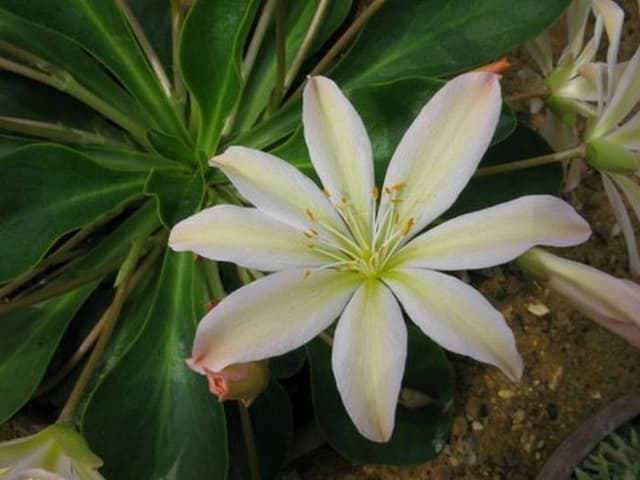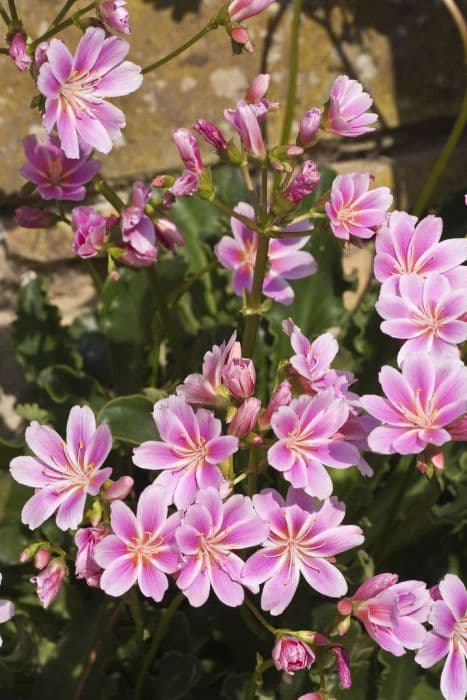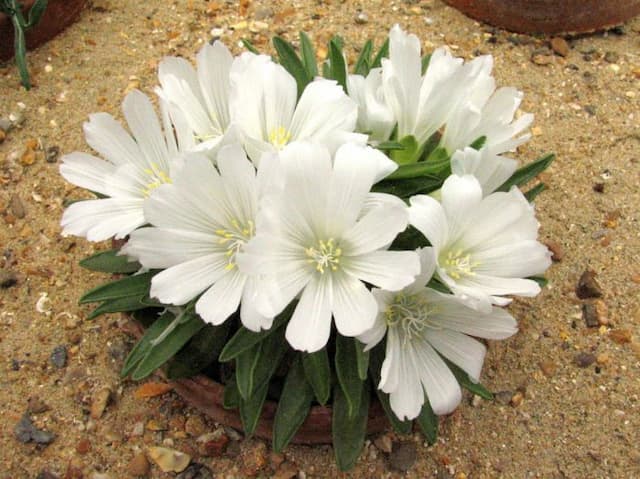Siskiyou Lewisia Lewisia cotyledon Sunset Group

ABOUT
The Lewisia cotyledon, commonly known as the Siskiyou lewisia or Cliff Maids, is a striking and colorful perennial plant known for its rosette formation. It bears spoon-shaped, fleshy evergreen leaves that are arranged in a whorled pattern, neatly circling the stem at the base of the plant. This foliage can carry a range of colors from green to reddish hues, depending on the specific variety and environmental conditions. The Siskiyou lewisia is most renowned for its vibrant, showy flowers, which bloom in a spectacular array of colors including pink, orange, yellow, white, and red. The blossoms are formed in clusters on top of slender, upright stalks that rise elegantly above the foliage rosette. Each flower consists of multiple petals, often with subtle color gradations and intricate patterns that may include stripes or spots. The floral display is particularly eye-catching when multiple colors are present within a single cluster, creating a sunset-like effect that is characteristic of this group. These plants typically bloom in spring or early summer, presenting a dazzling spectacle of color that can attract a variety of pollinators, such as bees and butterflies. The contrast between the lush, basal leaves and the vivid, upright blooms makes the Siskiyou lewisia a highly desirable plant for rock gardens, alpine collections, or as an ornamental accent in various garden settings. Its captivating appearance provides not only aesthetic value but also contributes to the biodiversity of garden environments by supporting pollinating insects.
About this plant
 Names
NamesSynonyms
Siskiyou Lewisia, Cliff Maids, Sunset Lewisia
Common names
Lewisia cotyledon Sunset Group.
 Toxicity
ToxicityTo humans
Siskiyou lewisia is not commonly known to be toxic to humans. However, as with any plant not intended for consumption, it is possible for sensitive individuals to experience mild stomach upset if any part of the plant is ingested. It is always advisable to avoid eating ornamental plants and to consult a medical professional if ingestion occurs and symptoms develop.
To pets
Siskiyou lewisia is not commonly known to be toxic to pets. In general, it is recommended to prevent pets from ingesting plants, as individual reactions can vary, and some plants can cause gastrointestinal upset even if they are not considered highly toxic. If a pet ingests part of the plant and shows signs of distress, it would be prudent to consult a veterinarian.
 Characteristics
CharacteristicsLife cycle
Perennials
Foliage type
Evergreen
Color of leaves
Green
Flower color
Varies
Height
1 foot [30 cm]
Spread
1 foot [30 cm]
Plant type
Herb
Hardiness zones
5
Native area
North America
Benefits
 General Benefits
General Benefits- Ornamental Appeal: Lewisia cotyledon, commonly known as Siskiyou lewisia, has vibrant, showy flowers that provide aesthetic value to any garden or landscape.
- Drought Tolerance: Siskiyou lewisia is known for its ability to withstand dry conditions, making it suitable for water-conservative landscaping or regions with water restrictions.
- Rock Garden Suitability: Its natural habitat is rocky slopes, so it is ideal for rock gardens or alpine garden settings.
- Cold Hardy: This plant can survive in cooler temperatures and is capable of withstanding frost, making it suitable for gardens in temperate zones.
- Low Maintenance: Siskiyou lewisia does not require frequent care beyond the basic needs, making it a low-maintenance option for gardeners.
- Attracts Pollinators: The colorful blossoms of Siskiyou lewisia attract bees and butterflies, which are vital for the pollination of gardens and ecosystems.
- Compact Size: Its small, compact form makes it ideal for use in borders, containers, and small garden spaces where size control is important.
- Seasonal Interest: Lewisia cotyledon Sunset Group offers seasonal blooms in spring and early summer, providing a burst of color when many other plants are not yet in their full glory.
- Variety of Colors: The Sunset Group cultivars come in a range of colors, allowing for versatility in garden color schemes and plant combinations.
- Long Bloom Period: With the right care and conditions, Siskiyou lewisia can have a lengthy bloom time, extending the visual enjoyment of its flowers.
 Medical Properties
Medical PropertiesThis plant is not used for medical purposes.
 Air-purifying Qualities
Air-purifying QualitiesThis plant is not specifically known for air purifying qualities.
 Other Uses
Other Uses- Lewisias can be grown in alpine troughs or containers where their beauty can be admired up close and drainage can be controlled.
- With their brightly colored blooms, lewisias make excellent candidates for pressing and can then be used in creating botanical art or decorations.
- You might plant lewisias between paving stones or in rock crevices, adding a pop of color to stonework and hardscaping elements in gardens.
- Lewisias can serve as a food source for pollinators like bees and butterflies, contributing to the health of the ecosystem by supporting biodiversity.
- Incorporating lewisias into a green roof project can add aesthetic value and help the structure blend into natural surroundings due to their resilience and shallow root system.
- They can also be used in educational settings, such as school gardens, to teach children about alpine plants and their specific growing requirements.
- As part of a miniature fairy garden, lewisias’s bright colors and small stature make them ideal to create a whimsical landscape.
- Garden photographers can use lewisias as stunning subjects to enhance their botanical portfolios with their range of vibrant colors and intricate flowers.
- The plant can be a natural indicator of the change in seasons, as lewisias typically bloom in the spring, signaling the end of winter.
- By planting lewisias in areas where soil erosion is a concern, their root systems can help stabilize the soil and prevent further degradation.
Interesting Facts
 Feng Shui
Feng ShuiThe Lewisia is not used in Feng Shui practice.
 Zodiac Sign Compitability
Zodiac Sign CompitabilityThe Lewisia is not used in astrology practice.
 Plant Symbolism
Plant Symbolism- Resilience: The Sunset Group Lewisia, also known as Bitterroot, often grows in harsh, rocky conditions, symbolizing an ability to thrive despite adversity.
- Survival: Bitterroot can survive in poor soils with minimal water, representing tenacity and the will to survive in challenging situations.
- Beauty: With its vibrant, diverse colors, Bitterroot symbolizes natural beauty and the appreciation of it, even in less-than-ideal circumstances.
 Water
WaterBitterroot or Lewisia cotyledon Sunset Group needs careful watering to avoid sitting in wet soil. During the growing season, water the plant when the top inch of soil feels dry, usually once a week, with about 16-24 ounces of water, depending on pot size and environmental conditions. Cut back on watering in the winter months, allowing the soil to dry out more between watering, potentially reducing to once every two weeks. It's important to provide adequate drainage to prevent root rot, so water thoroughly but allow excess water to drain away.
 Light
LightBitterroot thrives in bright, indirect light or partial shade. It's best to provide morning sunlight and shelter from the intense afternoon sun, which can scorch its leaves. A spot that offers sunlight in the morning and protection during the hottest part of the day is ideal. Avoid deep shade as it will stunt growth and reduce flowering.
 Temperature
TemperatureBitterroot prefers a temperature range between 60 and 75 degrees Fahrenheit for optimal growth. They can survive brief periods outside of this range, with minimum temperatures not dropping below 20 degrees Fahrenheit and maximum temperatures not exceeding 85 degrees Fahrenheit. However, consistently maintaining the ideal temperature range will encourage healthy growth and flowering.
 Pruning
PruningPrune Bitterroot to remove dead or wilted flowers and encourage further blooming. Trimming should be done after the main flowering period, usually in late spring or early summer. Cut back spent flower stalks and remove any damaged or yellowing leaves. Pruning helps maintain a tidy appearance and promotes the health of the plant.
 Cleaning
CleaningAs needed
 Soil
SoilBitterroot prefers a well-draining soil mix composed of a mixture of sand, fine gravel, or perlite mixed with compost and loam. Ideally, the soil pH should be slightly acidic to neutral, in the range of 6.0 to 7.0.
 Repotting
RepottingBitterroot should be repotted every two to three years or when it outgrows its current pot to refresh the soil and give the roots more room to grow.
 Humidity & Misting
Humidity & MistingBitterroot thrives in average room humidity levels and doesn't require any special humidity requirements.
 Suitable locations
Suitable locationsIndoor
Provide bright light and well-draining soil.
Outdoor
Plant in a sunny spot with excellent drainage.
Hardiness zone
4-8 USDA
 Life cycle
Life cycleThe Lewisia cotyledon, commonly known as the Siskiyou lewisia or cliff maids, begins its life cycle when seeds are sown in late winter or early spring. They germinate and develop into rosettes of fleshy, evergreen leaves from which a root system establishes to gather water and nutrients. During late spring to early summer, flower stalks develop, displaying clusters of star-shaped flowers in a range of colors that can attract pollinators for reproduction. Following pollination, the flowers produce seeds that mature by late summer or early fall, completing the reproductive cycle. As the plant enters dormancy in winter, it conserves energy to survive cold temperatures. With the onset of favorable conditions in the next cycle, such as increased temperature and daylight, the plant breaks dormancy, and the cycle begins anew with the growth of new leaves and flowers.
 Propogation
PropogationPropogation time
Spring-Early Summer
The most popular method of propagating Lewisia cotyledon, commonly known as Siskiyou lewisia, is by division. Division is best done in early spring as new growth begins. Gently loosen the soil around the plant and carefully lift it out, making sure to keep a good amount of root system intact for each division. Using a sharp, clean knife, divide the crown of the plant into smaller sections, each with a portion of the root system. Replant the divisions at the same depth they were previously grown, and water them well to help establish the newly divided plants. This method allows the plants to recover quickly and continue growing, producing flowers in the same season.




